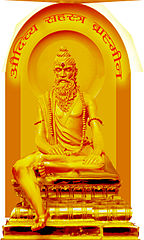Shastra: Unterschied zwischen den Versionen
Admdb1 (Diskussion | Beiträge) K Textersetzung - „<historylink type="back" style="font-family: Arial, Helvetica, sans-serif; font-size: 14px; color: #ffffff; padding: 4px 8px; float:right; background: -moz-linear-gradient( top, #fcf9fc 0%, #6a75eb); background: -webkit-gradient( linear, left top, left bottom, from(#fcf9fc), to(#6a75eb)); -moz-border-radius: 30px; -webkit-border-radius: 30px; border-radius: 30px; border: 3px solid #ffffff; -moz-box-shadow: 0px 3px 11px rgba(240,237,240,0.5), inset 0px 0px 1px rgba(000,145,255,1); -webkit-box-shadow: 0px 3px 11px rgba(240,237,240,0.5), inset 0px 0px 1px rgba(000,145,255,1); box-shadow: 0px 3px 11px rgba(240,237,240,0.5), inset 0px 0px 1px rgba(000,145,255,1); text-shadow: 0px -1px 0px rgba(000,000,000,0.2), 0px 1px 0px |
Adm1 (Diskussion | Beiträge) |
||
| (2 dazwischenliegende Versionen desselben Benutzers werden nicht angezeigt) | |||
| Zeile 19: | Zeile 19: | ||
* Olivelle, P. (2006). Explorations in the Early History of the Dharmaśāstra in P. Olivelle (ed.) Between the Empires: Society in India 300 BCE to 400 CE, New York: Oxford Unuiversity Press, ISBN 0-19-568935-6, ( S.169 ) | * Olivelle, P. (2006). Explorations in the Early History of the Dharmaśāstra in P. Olivelle (ed.) Between the Empires: Society in India 300 BCE to 400 CE, New York: Oxford Unuiversity Press, ISBN 0-19-568935-6, ( S.169 ) | ||
* [//www.holybooks.com/wp-content/uploads/Introduction-to-Tantra-Sastra.pdf Introduction-to-Tantra-Sastra ] PDF | * [//www.holybooks.com/wp-content/uploads/Introduction-to-Tantra-Sastra.pdf Introduction-to-Tantra-Sastra ] PDF | ||
* [https://books.google.de/books?id=ofU-DwAAQBAJ&pg=PA514&lpg=PA514&dq=Divyavadana+archive Hindu Law: A New History of Dharmaśāstra], Patrick Olivelle, Donald Richard Davis | |||
== Referenzen == | == Referenzen == | ||
| Zeile 25: | Zeile 26: | ||
== Weblinks == | == Weblinks == | ||
* en Wiki zum [//en.wikipedia.org/wiki/Shastra Shastra] | * en Wiki zum [//en.wikipedia.org/wiki/Shastra Shastra] | ||
* Indische [//sites.google.com/site/harshalarajesh/stotras Strotas] | * Indische [//sites.google.com/site/harshalarajesh/stotras Strotas] | ||
* [//www.vaastushaastra.com/vastuforkitchen.html Vastu für die Küche]...(s.a. Feng Shui) | * [//www.vaastushaastra.com/vastuforkitchen.html Vastu für die Küche]...(s.a. Feng Shui) | ||
| Zeile 31: | Zeile 31: | ||
* [//ksknair.hubpages.com/hub/Simples-rules-of-Vastu-Shastra-Science-of-Architecture Simle Rules of Vastu] | * [//ksknair.hubpages.com/hub/Simples-rules-of-Vastu-Shastra-Science-of-Architecture Simle Rules of Vastu] | ||
[[Kategorie:Buddhismus]] | [[Kategorie:Buddhismus]] | ||
[[Kategorie:Hinduismus]] | [[Kategorie:Hinduismus]] | ||
Aktuelle Version vom 25. Dezember 2019, 12:11 Uhr
Das Wort Shastra (śāstra) - auch sastra oder sahastra - bezeichnet eine Schrift, Lehre, Anweisung im allgemeinen Sinne.

Der Ausdruck śāstra findet sich zu ersten Mal in Yaska's Nirukta (1.2, 14). Das Ṛgvedaprātiśākhya (11.36; 14.30) benutzt das Wort, um sich auf die prātiśākhya - Tradition zu beziehen. Kātyāyana und Patañjali benutzen es unter bezug auf Pāṇini's Aṣṭādhyāyī.
Es kann sich dabei sowohl um Schriften religiöser als auch technischer Natur handeln wie Bhautika Shastra (Physik), Rasayana Shastra (Chemie), Jeeva Shastra (Biologie), Akshara-Laksha (Mathematik), Kaala Nirnaya(Zeit), Yantra Shastra(Landfahrzeuge), Vaimanika Shastra(Flugzeuge,Vimanas[1] ), Vastu Shastra (Architektur[2]), Shilpa Shastra (Mechanik, Skulptur-Herstellung), Artha Shastra (Wirtschaft, Reichtum [3]), Astra Shastra(Waffen) und Neeti Shastra(Politikwissenschaft).
Im Hinduismus bezieht sich der Begriff unter anderen auch auf die Veden, von denen es heißt, es gebe in deren Verbindung 14 oder 18 Shastras. Im Kātyāyana Śrautasūtra (1.6.21) wird der Ausdruck unter Bezug auf die Veden benutzt.
Das Wort wird auch kollektiv auf eine Ansammlung von Schriften angewendet wie das Vedanta Shastra (die Lehre des Vedanta), das Yoga Shastra (Lehre des Yoga), das Dharma Shastra (Gesetzbuch oder -bücher) mit dem Manusmriti, auf das Kavya Shastra (poetische Werke), das Shakti Tantra Shastra( handelt über Energien wie Maya, Prakriti, die 64 Arten von Energien der Natur, der Sonne, des Mondes und ihre Kräfte oder shaktis ), auf das Mantra Sastra, das Kama Shastra (erotische Literatur) und das Alamkara Shastra (Rhetorik).
In der buddhistischen Literatur ist ein Shastra zumeist ein erklärender Kommentar zu einer Schrift wie einem Sutra, der nicht von Buddha selbst stammt sondern z.B. von einem Kommentator.
Literatur
- Ratnaketu - parivarta, Sūryagarbha-parivarta and Candragarbha-parivarta of Mahāsaṃnipātasūtra(MSN) PDF
- Olivelle, P. (2006). Explorations in the Early History of the Dharmaśāstra in P. Olivelle (ed.) Between the Empires: Society in India 300 BCE to 400 CE, New York: Oxford Unuiversity Press, ISBN 0-19-568935-6, ( S.169 )
- Introduction-to-Tantra-Sastra PDF
- Hindu Law: A New History of Dharmaśāstra, Patrick Olivelle, Donald Richard Davis
Referenzen
- ↑ https://en.wikipedia.org/wiki/Vaimanika_Shastra Vaimanika_Shastra
- ↑ https://en.wikipedia.org/wiki/Vastu_shastra Vastu shastra
- ↑ https://sites.google.com/site/harshalarajesh/ancient-indian-shastras Indische shastras
Weblinks
- en Wiki zum Shastra
- Indische Strotas
- Vastu für die Küche...(s.a. Feng Shui)
- Vastu Basics
- Simle Rules of Vastu